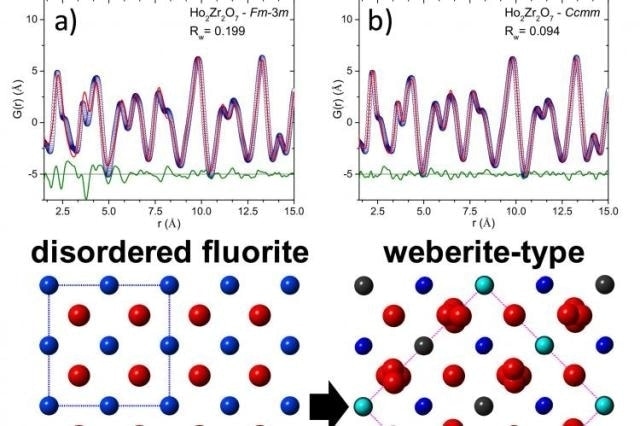Mar 8 2016
A study conducted by the University of Tennessee (UT) and the Department of Energy’s Oak Ridge National Laboratory (ORNL) could lead to creation of materials for energy-related applications.
 Defect fluorite materials such as Ho2Zr2O7 have been previously characterized as having a disordered cubic structure when sampled over many unit cell repeats. However, (a) pair distribution functions obtained from neutron total scattering reveals that description is inaccurate at the sub-nanometer level. Instead, (b) the local structure can be accurately modeled with an orthorhombic, weberite-type configuration revealing a complex disordering mechanism in these oxides, operating over different length scales (credit: ORNL).
Defect fluorite materials such as Ho2Zr2O7 have been previously characterized as having a disordered cubic structure when sampled over many unit cell repeats. However, (a) pair distribution functions obtained from neutron total scattering reveals that description is inaccurate at the sub-nanometer level. Instead, (b) the local structure can be accurately modeled with an orthorhombic, weberite-type configuration revealing a complex disordering mechanism in these oxides, operating over different length scales (credit: ORNL).
Three researchers from UT - Maik Lang, assistant professor of nuclear engineering; Haidong Zhou, assistant professor of physics; and Jacob Shamblin, a graduate research assistant in nuclear engineering and physics - conducted research on a key category of metal oxides.
Each material consists of two or more positively charged metallic ions and oxygen. The materials are used in fast ion conductors (used in solid oxide fuel cells), thermal barrier coatings for gas turbine jet engines, and host materials for nuclear waste containment.
The team used advanced neutron characterization approaches to gain a comprehensive insight into the nature of atomic design in these metallic oxides. The team’s work was published in the Feb. 29 issue of Nature Materials.
The complex oxides we analyzed in this study—pyrochlore and spinel—have been investigated for decades by different researchers. When subjected to extreme environments such as high temperatures or high-energy radiation, many of these compounds partially lose their long-range crystal structure, and the multiple cations were thought to randomly exchange crystal sites.
Maik Lang, Assistant Professor of Nuclear Engineering, University of Tennessee
According to Lang, the unique capabilities of ORNL’s Spallation Neutron Source, a DOE Office of Science User Facility, combined with the team members who were drawn from various disciplines, helped to discover a unique atomic disordering mechanism present in these materials.
Lang and his team, along with SNS instrument scientists Joerg Neuefeind and Mikhail Feygenson, utilized the Nanoscale-Ordered Materials Diffractometer (NOMAD) to gain an insight into the sample crystal structure. This is the first time that the NOMAD has been used on ion-irradiated materials to perform neutron scattering experiments. Neutrons are essential to conduct this type of research, as they can precisely sense the location of oxygen atoms of the materials.
Using neutrons to measure samples of such small sizes would have been difficult, if not impossible, just a few years ago. However, with the combination of the high neutron flux of SNS and the wide detector coverage of the NOMAD instrument, scientists can look at very small samples, which are typically the domain of X-ray scattering experiments.
Mikhail Feygenson, Instrument Scientist, SNS
When the data from the NOMAD was analyzed, they discovered that the oxygen atoms and the cations existing in the materials only appear to be randomly arranged when samples are taken on a large scale. This is an important discovery.
According to Lang, the non-homogenic disorder was not expected before. He adds that this phenomenon is found in other materials during harsh environments. The new discovery is important to control phonon transport and oxygen mobility in complex oxides, a crucial feature for technological applications.
With this understanding about the materials the team can control and improve the performance in several technologies, for instance, the immobilization and containment of nuclear waste.
This ability to accommodate atomic disorder in their structure accounts for the tendency of some compositions to resist becoming fully amorphous under irradiation or at high temperatures. Such materials find application as host materials for immobilizing actinides, such as plutonium. Predicting transport of radionuclides is important for their safe use as nuclear waste forms and requires a detailed knowledge of how the atomic structure responds to self-irradiation.
Maik Lang, Assistant Professor of Nuclear Engineering, University of Tennessee
According to Lang the data collected can provide information about atomic-scale information, ranging from the initial local defect structure to the long-range observable material modifications, in order to precisely simulate waste form properties and degradation.
The team’s other researchers include Cameron Tracy and Rodney Ewing of Stanford University, Fuxiang Zhang of the University of Michigan, and Sarah Finkeldei and Dirk Bosbach of the Forschungszentrum Jülich Institute of Energy and Climate Research in Germany.
The study received support as part of the Materials Science of Actinides, an Energy Frontier Research Center funded by DOE’s Office of Science.
ORNL is managed by UT-Battelle for DOE’s Office of Science, which is the largest supporter of basic research in the physical sciences in the United States to address the most pressing challenges.